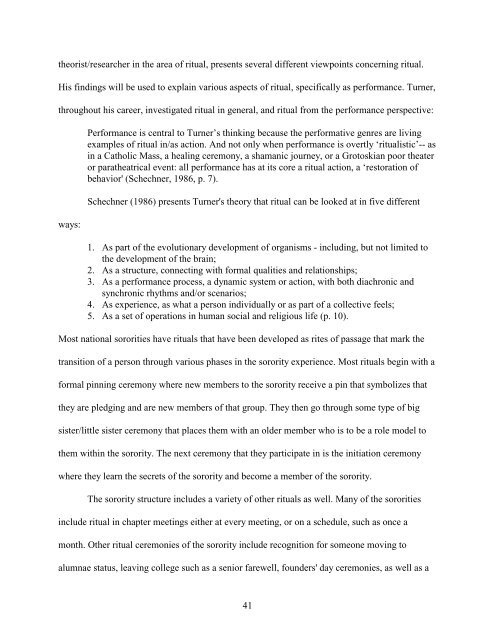Sorority Rituals - Reflections On Rites of ... - Mari Ann Callais
Sorority Rituals - Reflections On Rites of ... - Mari Ann Callais
Sorority Rituals - Reflections On Rites of ... - Mari Ann Callais
Create successful ePaper yourself
Turn your PDF publications into a flip-book with our unique Google optimized e-Paper software.
theorist/researcher in the area <strong>of</strong> ritual, presents several different viewpoints concerning ritual.<br />
His findings will be used to explain various aspects <strong>of</strong> ritual, specifically as performance. Turner,<br />
throughout his career, investigated ritual in general, and ritual from the performance perspective:<br />
ways:<br />
Performance is central to Turner’s thinking because the performative genres are living<br />
examples <strong>of</strong> ritual in/as action. And not only when performance is overtly ‘ritualistic’-- as<br />
in a Catholic Mass, a healing ceremony, a shamanic journey, or a Grotoskian poor theater<br />
or paratheatrical event: all performance has at its core a ritual action, a ‘restoration <strong>of</strong><br />
behavior' (Schechner, 1986, p. 7).<br />
Schechner (1986) presents Turner's theory that ritual can be looked at in five different<br />
1. As part <strong>of</strong> the evolutionary development <strong>of</strong> organisms - including, but not limited to<br />
the development <strong>of</strong> the brain;<br />
2. As a structure, connecting with formal qualities and relationships;<br />
3. As a performance process, a dynamic system or action, with both diachronic and<br />
synchronic rhythms and/or scenarios;<br />
4. As experience, as what a person individually or as part <strong>of</strong> a collective feels;<br />
5. As a set <strong>of</strong> operations in human social and religious life (p. 10).<br />
Most national sororities have rituals that have been developed as rites <strong>of</strong> passage that mark the<br />
transition <strong>of</strong> a person through various phases in the sorority experience. Most rituals begin with a<br />
formal pinning ceremony where new members to the sorority receive a pin that symbolizes that<br />
they are pledging and are new members <strong>of</strong> that group. They then go through some type <strong>of</strong> big<br />
sister/little sister ceremony that places them with an older member who is to be a role model to<br />
them within the sorority. The next ceremony that they participate in is the initiation ceremony<br />
where they learn the secrets <strong>of</strong> the sorority and become a member <strong>of</strong> the sorority.<br />
The sorority structure includes a variety <strong>of</strong> other rituals as well. Many <strong>of</strong> the sororities<br />
include ritual in chapter meetings either at every meeting, or on a schedule, such as once a<br />
month. Other ritual ceremonies <strong>of</strong> the sorority include recognition for someone moving to<br />
alumnae status, leaving college such as a senior farewell, founders' day ceremonies, as well as a<br />
41



